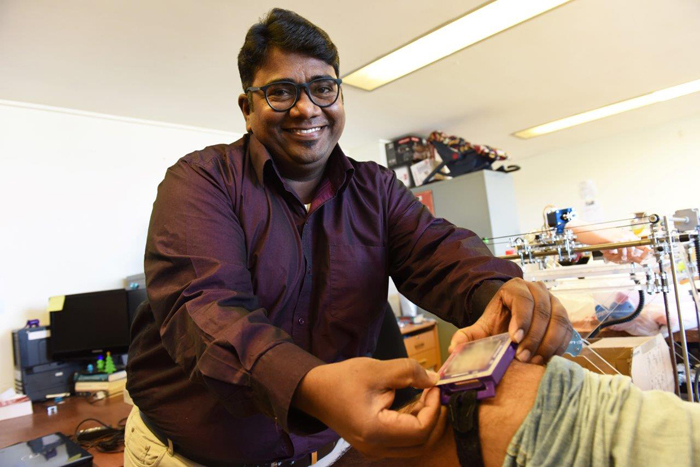Sudesh Sivarasu: Clinician-centred innovation
04 November 2016 | Story by Newsroom
Dr Sudesh Sivarasu's path to becoming a prolific inventor of biomedical devices has had its twists and turns.
As a child, he was mesmerised by the locomotives that thundered down the railways in his hometown near Chennai in India. He also loved to conduct experiments, especially if they included fire, which led to him almost burning down the family home more than once.
So, while it was not surprising that he elected to study engineering at an undergraduate level, his choice of business as a subject for his graduate studies was unexpected. Sivarasu was about to take up a place in a prestigious business studies programme abroad when he had a car accident that led to six months of rehabilitation and him having to give up his place in the programme.
“I didn't know it at the time, but it was really a blessing in disguise. It led me to taking a course in biomedical engineering and specifically a class in rehabilitation engineering. The man that taught that class, Professor Lazar Mathew, became my PhD supervisor and is still my mentor today,” Sivarasu says.
Cue the second plot twist: despite having a promising academic career in India, Sivarasu then elected to come to UCT.
“Everyone thought I was mad,” he says, “My fiancée even asked me where Cape Town was, but now we have been here for years and my fiancée, who is now my wife, loves it as much as I do.”
Frugal Biodesign Process
Soon after he arrived, Sivarasu noticed two specific characteristics of biomedical technology in South Africa. The first was that almost all biomedical devices were imported, even medical consumables such as IV lines. The other was the fact that there existed a more collaborative culture among local physicians.
“In India, doctors expect to be treated as gods. Here they are willing to work with partners to solve problems,” he explains.
At the time, Sivarasu was trying to figure out why his first invention, a type of knee prosthesis, had not made it to market. He realised that up to that point he had considered the patient to be the central client in the innovation process, but that in fact it should be the clinician. The patient remained the end user, but the clinician was the one who had to buy the device or at the very least sign off on its use. According to Sivarasu, this had a revolutionary effect on the user-friendliness and effectiveness of his devices.
especially things that work
and have real-world applications.”
Based on this concept, Sivarasu also designed what he affectionately calls his Frugal Biodesign Process. This model starts with consulting with the end user to define a hierarchy of needs that a device must answer to, followed by stages of conceptualisation, intellectual property (IP) roll out and commercialisation. As a senior lecturer it is a model that he has used with great success with his biomedical engineering students, and with his own projects.
In the five years since he arrived at UCT, Sivarasu has invented numerous devices with applications covering everything from stroke rehabilitation and asthma therapy to childhood medicine and knee-joint surgery. Sivarasu has received a number of national and international awards for these devices.
“UCT has great support services to researchers,” Sivarasu says, “but still a limited range of spin-off companies.”
Sivarasu believes that this is due to a lack of attention towards product-related research.
“As an academic, I am expected to publish high impact papers, but as an engineer I want to make things, especially things that work and have real-world applications. I think we must move towards translatable research. There is a lot of emphasis on publication-driven research and citations, but I believe that we can make a difference in the world we live in only if we start thinking outside the regular boundaries of academia and start focusing on real-life problems, which are real-time opportunities to serve people.”
Story Ambre Nicolson. Photo Michael Hammond.
 This work is licensed under a Creative Commons Attribution-NoDerivatives 4.0 International License.
This work is licensed under a Creative Commons Attribution-NoDerivatives 4.0 International License.
Please view the republishing articles page for more information.










